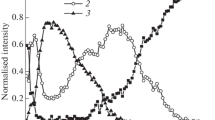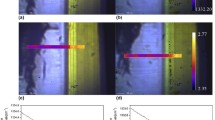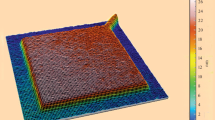Abstract
The formation of Au/Mo/Ti ohmic contacts to p-diamond epitaxial films has been studied. Specifically, the influence of annealing on the electrical properties and structure of contacts has been investigated. It has been shown that the upper gold layer protects the contact system against oxidation up to 850°C during RTA unlike the case of a “simplified” Au-free Mo/Ti system frequently used in today’s solutions. In Mo-free Au/Ti systems, high-temperature annealing causes effective diffusion of titanium into the gold layer, which deteriorates the protective properties of the latter and enhances oxygen diffusion toward the interface with diamond. Oxidation of the Ti/C contact area prevents the formation of a titanium carbide conducting layer, which has high adhesion to diamond. The role of various factors, namely, annealing to form titanium carbide, heavy doping of diamond with boron, and crystal perfection of diamond films, in lowering the contact resistance, has been estimated. For doped epitaxial films grown on single-sector substrates, unalloyed ohmic contacts with a record low contact resistance of 4 × 10–7 Ω/cm2 have been obtained.











Similar content being viewed by others
REFERENCES
J. Y. Tsao, S. Chowdhury, M. A. Hollis, D. Jena, N. M. Johnson, K. A. Jones, R. J. Kaplar, S. Rajan, C. G. Van de Walle, E. Bellotti, C. L. Chua, R. Collazo, M. E. Coltrin, J. A. Cooper, K. R. Evans, et al., Adv. Electron. Mater 4, 1600501 (2018). https://doi.org/10.1002/aelm.201600501
Power Electronics Device Applications of Diamond Semiconductors, Ed. by S. Koizumi, H. Umezawa, J. Pernot, and M. Suzuki (Elsevier, 2018).
T. V. Blank and Yu. A. Gol’dberg, Semiconductors 41, 1263 (2007).
J. F. Prins, J. Phys. D: Appl. Phys. 22, 1562 (1989).
R. Kalish, Appl. Surf. Sci. 117/118, 558 (1997).
V. Venkatesan, D. M. Malta, K. Das, and A. M. Belu, J. Appl. Phys. 74, 1179 (1993).
J. C. Pinero, M. P. Villar, D. Araujo, J. Montserrat, B. Antunez, and P. Godignon, Phys. Status Solidi A 214, 1700230 (2017). https://doi.org/10.1002/pssa.201700230
T. Tachibana, B. E. Williams, and J. T. Glass, Phys. Rev. B 45, 11975 (1992).
J. Nakanishi, A. Otsuki, T. Oku, O. Ishiwata, and M. Murakami, J. Appl. Phys. 76, 2293 (1994).
M. Yokoba, Y. Koide, A. Otsuki, F. Ako, T. Oku, and M. Murakami, J. Appl. Phys. 81, 6815 (1997).
P. E. Viljoen, E. S. Lambers, and P. H. Holloway, J. Vac. Sci. Technol. B 12, 2997 (1994). https://doi.org/10.1116/1.587549
K. L. Moazed, J. R. Zeidler, and M. J. Taylor, J. Appl. Phys. 68, 2246 (1990).
Y. Chen, M. Ogura, S. Yamasaki, and H. Okushi, Semicond. Sci. Technol. 20, 860 (2005). https://doi.org/10.1088/0268-1242/20/8/041
S. Kono, T. Teraji, H. Kodama, K. Ichikawa, S. Ohnishi, and A. Sawabe, Diamond Related Mater. 60, 117 (2015). https://doi.org/10.1016/j.diamond.2015.10.028
D. Zhao, F. N. Li, Z. C. Liu, X. D. Chen, Y. F. Wang, G. Q. Shao, T. F. Zhu, M. H. Zhang, J. W. Zhang, J. J. Wang, W. Wang, and H. X. Wang, Appl. Surf. Sci. 443, 361 (2018). https://doi.org/10.1016/j.apsusc.2018.03.015
W. P. Leroy, C. Detavernier, R. L. van Meirhaeghe, A. J. Kellock, and C. Lavoie, J. Appl. Phys. 99, 063704 (2006). https://doi.org/10.1063/1.2180436
W. P. Leroy, C. Detavernier, R. L. van Meirhaeghe, and C. Lavoie, J. Appl. Phys. 101, 053714 (2007). https://doi.org/10.1063/1.2561173
S. Ohmagari, T. Matsumoto, H. Umezawa, and Y. Mokuno, MRS Adv. 1, 3489 (2016). https://doi.org/10.1557/adv.2016.471
F. Fang, C. A. Hewett, M. G. Fernandes, and S. S. Lau, IEEE Trans. Electron Devices 36, 1783 (1989).
M. Werner, O. Dorsch, H.-U. Baerwind, E. Obermeier, C. Johnston, P. R. Chalker, and S. Romani, IEEE Trans. Electron Devices 42, 1334 (1995).
M. Werner, Semicond. Sci. Technol. 18, 41 (2003). https://doi.org/10.1088/0268-1242/18/3/306
G. R. Brandes, C. P. Beetz, C. F. Feger, R. W. Wright, and J. L. Davidson, Diamond Relat. Mater. 8, 1936 (1999).
G. Civrac, S. Msolli, J. Alexis, O. Dalverny, and H. Schneider, Electron. Lett. 46, 791 (2010). https://doi.org/10.1049/el.2010.0803
M. P. Dukhnovskii, A. K. Ratnikova, and Yu. Yu. Fedorov, RF Patent No. 2436189, Byull. Izobret., No. 34 (2011).
L. A. Vikharev, A. M. Gorbachev, M. A. Lobaev, A. B. Muchnikov, D. B. Radishev, V. A. Isaev, V. V. Chernov, S. A. Bogdanov, M. N. Drozdov, and J. E. Butler, Phys. Status Solidi RRL 10, 324 (2016). https://doi.org/10.1002/pssr.201510453
M. N. Drozdov, Yu. N. Drozdov, M. A. Lobaev, and P. A. Yunin, Tech. Phys. Lett. 44, 297 (2018). https://doi.org/10.1134/S106378501804003X
M. P. Alegre, D. Araujo, A. Fiori, J. C. Pinero, F. Lloret, M. P. Villar, P. Achatz, G. Chicot, E. Bustarret, and F. Jomard, Appl. Phys. Lett. 105, 173103 (2014). https://doi.org/10.1063/1.4900741
Funding
This study was financially supported by the Russian Foundation for Basic Research (grant no. 18-02-00565) and the Russian Science Foundation (grant no. 17-19-01580).
Author information
Authors and Affiliations
Corresponding author
Ethics declarations
The authors claim that they do not have any conflicts of interest.
Additional information
Translated by V. Isaakyan
Rights and permissions
About this article
Cite this article
Drozdov, M.N., Demidov, E.V., Drozdov, Y.N. et al. Formation of Low-Resistivity Au/Mo/Ti Ohmic Contacts to p-Diamond Epitaxial Layers. Tech. Phys. 64, 1827–1836 (2019). https://doi.org/10.1134/S1063784219120041
Received:
Revised:
Accepted:
Published:
Issue Date:
DOI: https://doi.org/10.1134/S1063784219120041




